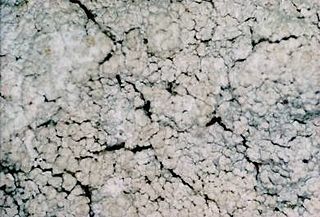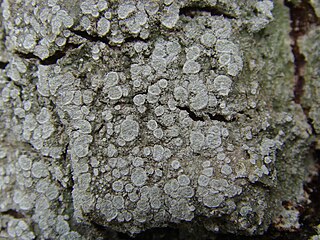
The Ramalinaceae are a family of lichen-forming fungi in the order Lecanorales. First proposed by Carl Adolph Agardh in 1821, the family now comprises 63 genera and about 750 species. Ramalinaceae lichens exhibit diverse growth forms, including crustose, fruticose, squamulose, leprose, and byssoid thalli, and form symbiotic relationships primarily with green algae of the genus Trebouxia. The family is characterised by pale-coloured thalli, apothecia that are typically pale but may darken with age, and ascospores that vary in shape and septation.

Micarea is a genus of lichen-forming fungi in the family Pilocarpaceae. The widely distributed genus contains 142 species and new species are described actively. Species in the genus are crustose lichens and their photobiont is a single-celled green alga.

Fuscidea is a genus of crustose lichens in the family Fuscideaceae. It has about 40 species. The genus was circumscribed in 1972 by lichenologists Volkmar Wirth and Antonín Vězda, with Fuscidea aggregatilis assigned as the type species.

Lepraria is a genus of leprose crustose lichens that grows on its substrate like patches of granular, caked up, mealy dust grains. Members of the genus are commonly called dust lichens. The main vegetative body (thallus) is made of patches of soredia. There are no known mechanisms for sexual reproduction, yet members of the genus continue to speciate. Some species can form marginal lobes and appear squamulose. Because of the morphological simplicity of the thallus and the absence of sexual structures, the composition of lichen products are important characters to distinguish between similar species in Lepraria.
Sagenidiopsis isidiata is a species of corticolous (bark-dwelling) byssoid lichen in the family Arthoniaceae. Found in tropical montane rainforests throughout Central America, South America, and the Antilles, it was described as new to science in 2011. The lichen is characterised by its cream-coloured to greyish thallus and numerous pseudoisidia, which are small, cylindrical outgrowths on its surface.

Malmidea is a genus of crustose lichens and the type genus of the family Malmideaceae. It was established in 2011 to contain a phylogenetically distinct group of species formerly placed in the genus Malcolmiella. The crust-like thallus of Malmidea lichens has a surface that varies from smooth to rough, featuring textures such as verrucose (wart-like), granulose (grainy), or pustulate (pimpled). These textures are often formed by goniocysts, which are spherical clusters of green algal cells from the family Chlorococcaceae, encased in fungal hyphae. Malmidea comprises nearly 70 mostly tropical species that grow on bark, although a few grow on leaves.

Loxospora is a genus of lichen-forming fungi in the family Sarrameanaceae. It has 13 species. The genus was circumscribed by Italian lichenologist Abramo Bartolommeo Massalongo in 1852, with Loxospora elatina assigned as the type species. This crustose lichen was originally named Lecanora elatina by Erik Acharius in 1810.

Lepraria incana is a species of dust lichen in the family Stereocaulaceae. First described scientifically by Johann Jacob Dillenius in 1741, and then formally by Carl Linnaeus in 1753, it is the type species of the genus Lepraria. The thallus of this species is green to greyish-green, and powdery – as if made of tiny granules. These granules are soredia, which are asexual reproductive structures. Like most members of genus Lepraria, the lichen has few distinguishing features, lacking both a medulla and sexual reproductive structures (apothecia). Chemically, the lichen is characterised by the presence of the secondary chemicals known as divaricatic acid and zeorin.
Parmelia imbricaria is a species of foliose lichen in the family Parmeliaceae. Found in western Canada, it was formally described as a new species in 2017 by Trevor Goward, Pradeep Kumar Divakar, María del Carmen Molina, and Ana Crespo. The type specimen was collected by Goward near the Clearwater River drainage, where it was found at an altitude of 700 m (2,300 ft) growing on a basalt boulder. The specific epithet refers to the "imbricate" lobes of the thallus. The lichen occurs in western Canada, with a range including southern Yukon and extending south to southern inland British Columbia. The European Parmelia pinatifida is a closely related species.

Lepra is a genus of lichen-forming fungi in the family Pertusariaceae. Although the genus was created in 1777, it was not regularly used until it was resurrected in 2016 following molecular phylogenetic analyses. It has more than a hundred species, most of which were previously classified in genus Pertusaria.
Chrysothrix bergeri is a species of crustose lichen in the family Chrysotrichaceae. It is found in the southeastern United States and the Caribbean, where it grows as a bright yellow, powdery crust on the bark and wood of mostly hardwoods.

Malmidea attenboroughii is a species of corticolous (bark-dwelling), crustose lichen in the family Malmideaceae. It is known to occur from a single location in the Amazon rainforest of Bolivia.

Fuscidea multispora is a species of foliicolous (leaf-dwelling), crustose lichen in the family Fuscideaceae. Found in Bolivia, it is known to occur only in a single high-altitude locality in a national park, where it grows on the leaves of coniferous trees from the genus Podocarpus.
Micarea pauli is a species of corticolous and lignicolous, crustose lichen in the family Pilocarpaceae. It is only known to occur in Poland's Białowieża Forest.
Bacidina flavoleprosa is a species of saxicolous (rock-dwelling), leprose (powdery) lichen in the family Ramalinaceae. It is found in a single locality in the Czech Republic.
Astrothelium chulumanense is a little-known species of corticolous (bark-dwelling), crustose lichen in the family Trypetheliaceae. Found in the Yungas montane forest of Bolivia, it was formally described as a new species in 2023. It is characterized by pseudostromata not differing in colour from the thallus, perithecia immersed for the most part in the thallus with the upper part elevated above and covered with orange pigment, apical and fused ostioles, the absence of lichexanthone, a clear hamathecium, eight-spored asci, and large, muriform ascospores with a thickened median septum.

Chrysothrix chlorina, the sulphur dust lichen, is a species of leprose (powdery) crustose lichen in the family Chrysotrichaceae. Originally described scientifically by the Swedish lichenologist Erik Acharius over 200 years ago, it has been shuffled to many different genera in its taxonomic history before finally being transferred to Chrysothrix in 1981. The lichen has a circumboreal distribution, meaning it occurs in northern boreal regions across the planet. It is typically saxicolous (rock-dwelling), particularly on the underside of rock overhangs, but has in rare instances been recorded growing on bark and various other surfaces.
Chrysothrix tchupalensis is a little-known species of saxicolous (rock-dwelling), powdery lichen in the family Chrysotrichaceae. It occurs in north Queensland, Australia. The lichen forms a powdery, bright yellow thallus that grows on sheltered, humid rocks in a tropical rainforest environment.
Malmidea cineracea is a little-known species of corticolous (bark-dwelling), crustose lichen in the family Malmideaceae. It is found in Nicaragua.
Lithocalla is a small genus of lichen-forming fungi in the family Ramalinaceae. It comprises two known species that form crust-like growths with a powdery texture on rocks. The genus was established in 2020 based on genetic analysis of species previously classified under different genera. Lithocalla lichens are characterised by their pale yellow-green colour and their preference for sheltered, shaded rock surfaces. They lack visible reproductive structures and likely spread through fragmentation. The two species have distinct geographical distributions: L. ecorticata is found mainly in Great Britain and Norway, while L. malouina is native to the Falkland Islands.










